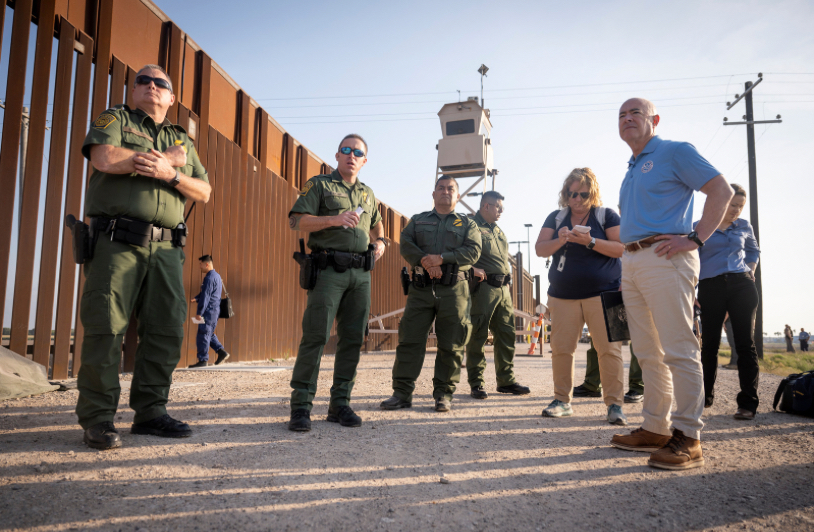Biden Set to Enact Stricter Asylum Cap in Response to Political Pressures and Rising Migrant Numbers
Belatedly, Joe Biden is scheduled to sign an executive order as early as today to cut off asylum requests from migrants when they hit a cap.
It’s a move that will show up all the flaws in our system, and highlight a changing public attitude toward immigration, legal or not. It will be an exercise in futility, not a game-changer.
Biden is issuing the order from a perceived demand that he do so, political pressure from Republicans at large and from Democratic office-holders who have found the sheer numbers of migrants needing services to be overwhelming.
But he is also doing so because Republicans — including those who helped negotiate a package legislative deal — decided to resist, and have declined to let Biden out of what they see as an unpopular enforcement box that favors stronger enforcement than he is willing to back. In short, think of this as electoral politics. As CNN noted, even if it does not emerge today, expect it before a presidential debate at the end of June.
As The New York Times notes, “The decision shows how the politics of immigration have tilted sharply to the right over the course of Biden’s presidency. Polls suggest growing support, even inside the president’s party, for border measures that once Democrats denounced and Trump championed.”
Biden is taking a page from Donald Trump’s playbook to block migrants — but refusing to go anywhere near as far to do so.
Still, the frailty of an executive order rather than congressional legislation is certain to go to court, as other versions of such orders have done, where the outcome is anything but certain. Past orders have been thrown out as unconstitutional, for example.
For immigration proponents, this is an unwarranted order that will take away protections from migrants will support misleading claims generally about immigration.
Details Still Forming
The details were still being worked on yesterday, but already was being described as the most restrictive such effort by a Democrat, recalling similar efforts by Trump. The order would allow border officials to block asylum claims once and border crossings exceed a certain threshold — thought to be about 5,000 a week — and not apply to minors arriving alone. Critics say that is still way too many.
Last week, there were about 3,500 crossings reported.
Although numbers of migrants crossing and surrendering to border authorities to claim asylum have ebbed in the last four months, the totals remain high. Indeed, the single-most important factor seems to have been more aggressive policies in Mexico to keep various migrant groups from even approaching the U.S. border.
Biden also ordered opening offices in various countries to allow for asylum requests to be filed without queueing at the border.
Republican border state governors have been busing or flying migrants to northern, Democratic cities in response, and mayors across the country have been screaming about having to pay for unguided shelter expenses. Republicans view the border effects as a law enforcement issue. Democrats broadly are more open to seeing the border as an expression of humanitarian issues.
However they define it, the problem, of course, is that a choked immigration and asylum system cannot process all the claims, and that border officials release asylum applicants to await trial dates that may occur months or years into the future.
Republicans ridicule this process as “catch and release,” and insist that no one be allowed to come across the border without physical vetting through identified gates. With exceptions, Democrats generally call this a system that needs more agents and immigration judges, as well as a comprehensive, understandable immigration bill to make this sensible.
What Americans forget is that asylum applications are “legal,” but that does not stop critics from conflating illegal crossings with asylum requests, or special handling for minors, or those who are part of the DACA (Deferred Action for Childhood Arrivals) program — or those who come from designated countries under Temporary Protection status. There is a tangible “us” and “them” quality to immigration discussions that cross all kinds of personal boundaries — racial, background, legality, perceived criminal records and length of stay.
Difficult Solutions
Just as law enforcement resources are stretched too tautly, so are services and arrangements to shelter migrants or make quicker work permits available. It all works to keep migrants in the shadows, working undocumented jobs for cash and avoiding the authorities.
Trump vows to go much further than any Biden program to stop entry into the country, set up huge deportation camps, and to prosecute and deport 11 million undocumented people of all ages. Just how that would work is never laid out. And then there is Trump’s border wall, which is spotty and apparently ineffective.
The bill Biden agreed to with Republicans from the Senate in February would have provided billions of dollars for the border, including the hiring of thousands of asylum officers to process claims. After Trump intervened, Republicans said no to the bill, saying that they did not want to give Biden a legislative victory in an election year.
Administration officials have said that executive action is not their preference — and that they believe any order would face a legal challenge.
Polls consistently have found that Trump was seen as a much stronger voice on the border than Biden. Biden has shifted, but essentially wants a more comprehensive view of immigration policy than providing more law enforcement officers.
American voters naturally just want there to be no problem, and the best legal path is either too complicated or too boring a topic even to earn polling questions.




